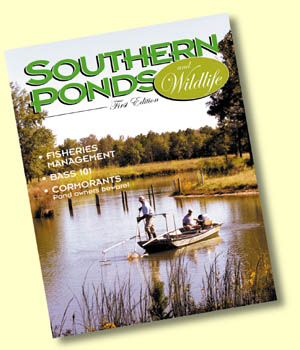Reeling In Readers – Alabama Hatchery Launches Pond Management Publication

When the phone rings at American Sport Fish–one of the largest private fish hatcheries in the Southeast located near Montgomery–it’s most likely a customer wanting information on when to stock their pond, how to apply fertilizer, or one of scores of other questions answered daily by hatchery owners Barry Smith and Don Keller.”Today’s pond owners are different from most pond owners of 30 or 40 years ago,” said Keller. “Back then, a pond was built primarily for watering livestock. The owner would usually stock it with fish and maybe apply fertilizer a time or two, but that was about it. Today’s pond owner constructs a pond primarily for fish production, whether it is for recreational or commercial use, and they want the latest information on pond management.”It is this new breed of pond owners, those wanting the latest information on pond management, that inspired Keller and Smith to launch a quarterly magazine–Southern Ponds & Wildlife.”We have been discussing starting a magazine to benefit our customers for some time,” said Smith. “We answer the same questions from customers everyday, such as: ‘How do I grow trophy bass?’ ‘How many fish should I harvest per acre?’ ‘What size fish should be removed?’ ‘How do I provide supplemental feed to bluegills, etc?'”A lot of this information is not readily available to the land owners in printed form, and even when you discuss these topics on the phone, the land owner usually does not have printed material to refer back to,” Smith added.Both Keller and Smith are quick to point out that Southern Ponds & Wildlife will not be a “How To Catch Fish” publication. “We will not be doing articles on how to fish plastic worms or crankbaits. There is an abundance of good outdoor magazines out there that cover baits and fishing tactics,” Keller said. “We will leave that to the fishing magazines while we concentrate on producing “How To” articles geared to production and management of fisheries and wildlife.”According to Smith, every issue of Southern Ponds & Wildlife will feature case studies of one or two pond owners who have been successful in what they have accomplished by utilizing the most modern, proven management techniques. Articles on state-of-the-art fisheries research written by contributing authors who have a proven expertise in their field will appear regularly.”All of our articles will be written with the sole objective of providing practical information to the landowner so that they can take and apply the management practices immediately to their particular situation,” said Smith. “For example, we plan to have at least one article in every issue on aquatic plants that cause problems, such as filamentous algae and mosses. Through this publication, we will be able to better educate the landowner on how to identify and control these plants.” Keller says some pond owners are experiencing significant fish loss due to aquatic wildlife, such as otters, fish-eating birds, turtles and snakes.”Our publication will cover how to determine if you have a problem and how to control aquatic wildlife that does become a problem,” he said. “For instance, problems with otters are severe in some areas. Otters come in and feed mostly at night and often go undetected until the damage is done. A mature otter can eat 10 pounds of fish daily. A small pond’s fishable population can literally be depleted if otters are not controlled. Articles on identifying otter trails, droppings and control measures will be included,” Keller added.An article covering cormorants also will appear early on in the publication.”Expanding cormorant populations pose one of the greatest threats when it comes to fish predation,” said Smith. “We’ve had pond owners call in and say they have had as many as 500 cormorants land on their pond. These birds are fish-killing machines that can dive deep and stay submerged for extended periods of time. Also, their feeding is not limited to small fish. Cormorants can swallow fish up to 12 inches in length, making them a significant threat to both recreational fisheries and aquaculture.”Cormorants are protected as migratory birds, but we will cover procedures on how to get permits and techniques to harass or eliminate these fish-eating birds,” Smith added. “We will cover the use of the ‘Bird Banger,’ a pistol that fires a small explosive similar to a cherry bomb to scare cormorants off a pond. How to use beach balls with an owl painted on it and the use of inflatable plastic alligators as a deterrent also will be discussed.”Keller says Southern Ponds & Wildlife will address these subjects and much more, including recipes for preparing fish.”We believe our publication will fulfill a niche that has not been addressed by traditional outdoor magazines. It will combine historical methods with cutting-edge research and the most current successful management policies to guide the landowner toward achieving a quality pond,” Keller said.
EDITOR’S NOTE:> To subscribe to Southern Ponds & Wildlife, send $28 for a one-year subscription to: Southern Ponds & Wildlife, Subscription Dept., P.O. Box 240729, Montgomery, Al. 36124-0729.Outdoor writer Ben Norman lives in Crenshaw County.
